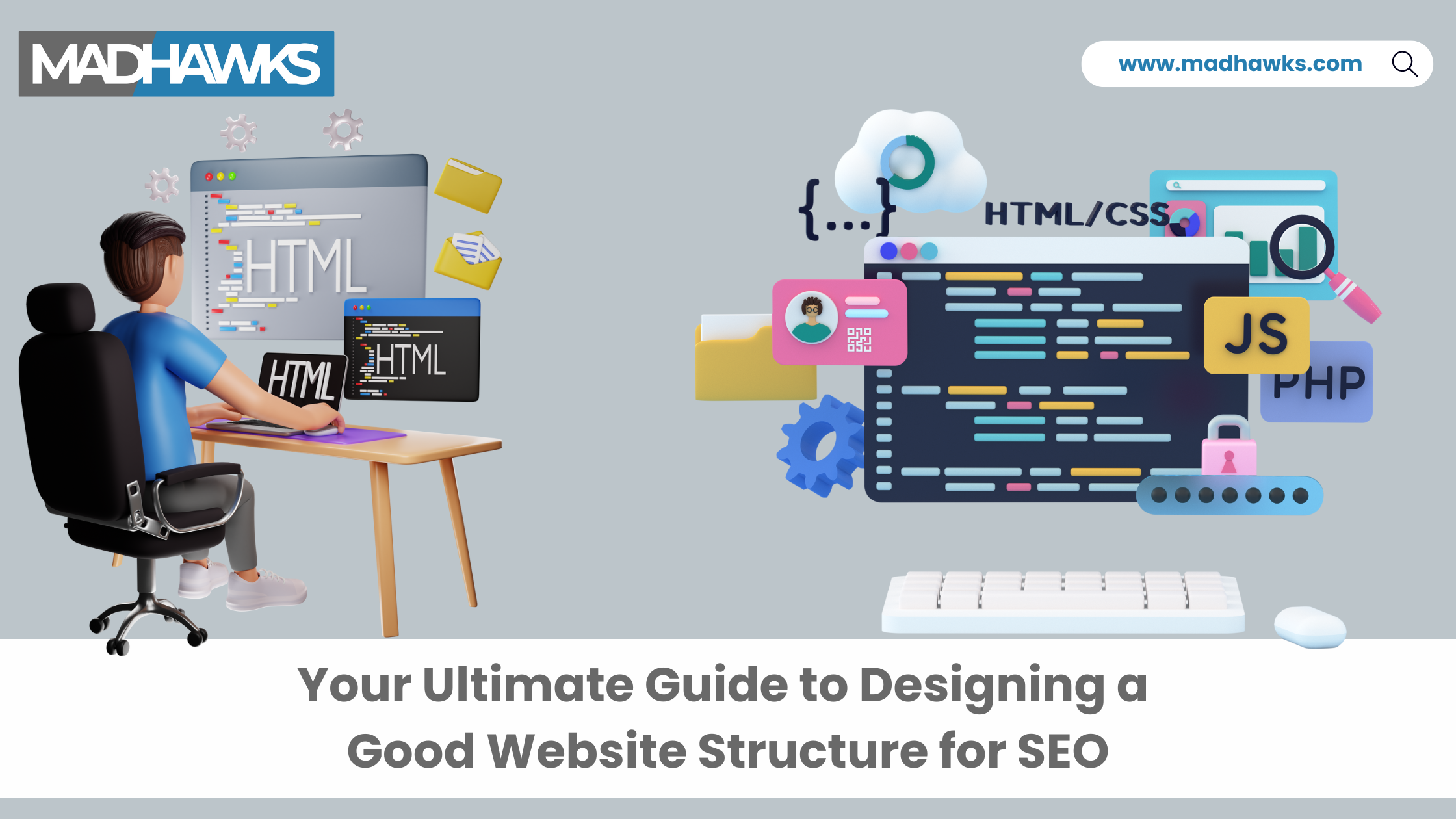Your Ultimate Guide to Designing a Good Website Structure for SEO
Posted By Gaurav | 22-May-2024 | Search Engine Optimization
As per a survey, 94% of users say that easy navigation of a website is the most important feature that matters to them. In order to ensure easy navigation, one needs a good website architecture. An easy-to-navigate website means a site where users can easily reach any page in just a few clicks. Its interface should be easy to understand for users as well as for search engines.
The structure of a website not only matters for good user experience, but it also plays a crucial role in the SEO performance of your site. The better your website’s structure, the better user experience and SEO performance it offers. Let us dive deeper into what a good website structure looks like and how you can achieve it:
What is Website Structure and Why It Matters?

Website structure refers to the ways pages and content are organized or arranged on a particular website. It is like a roadmap for the search engine crawlers that they use to find and index a website’s content. Website structure also plays an important role in user experience. The better a site’s structure is, the better experience it will offer to users.
As Google now prioritizes user experience to determine a website’s rankings on SERPs, a good website structure can be a contributing factor affecting your site’s performance. Along with offering a good user experience, it also helps search engine crawlers find content on the site and index it on Google, which is an added advantage.
Importance of Good Website Structure
A good website structure is important for multiple reasons, some of which are mentioned below:
1. Seamless User Experience
A good website architecture ensures that users can easily find whatever they are looking for on a site. An easy-to-navigate website with a well-arranged layout can improve user experience and reduce the bounce rate. It also encourages users to stay on your website for longer periods, which ultimately boosts your site’s rankings on search engines.
2. Better Search Engine Crawling
The structure of a website also determines how easy or difficult it is for search engine crawlers to find and crawl through your site. A well-designed website with a proper internal linking structure helps crawlers discover your website pages and coral them.
3. Helps Get Sitelinks
Sitelinks are the links from the same website that are clustered under a Google search result. As of now, website owners cannot add sitelinks on their own. Google displays sitelinks for websites that have a good site structure. This is yet another benefit that you might get by having a good site structure.
4. Avoid Competing With Your Own Web Pages
You might have different web pages or blog posts around the same primary keyword on your website. But all of them might be covering different aspects of the same topic. But without a good site structure and proper internal linking, search engines cannot understand which of these pages are the most important or which one should be displayed for a particular query. By properly arranging these pages and linking them with one another, you can help search engines understand the same.
Steps to Build an SEO-Friendly Website Structure
Here is a detailed step-by-step guide that you can use to build an SEO-friendly website structure:
1. Start by Creating a Strategic Plan
Before you actually start designing or redesigning your website, create a rough plan of how you want your website to look. Note down all the categories and subcategories that should be there. Also, decide on the hierarchy of pages to help search engines understand which page is more important. By preparing a basic skeleton of your website, you can start with the right steps to design the type of website you want.
2. Minimize The Number of Clicks
You should try to keep the number of clicks to reach a specific page as few as possible. The more clicks a user has to make, the less likely they are to visit your website again. Ideally, users should be able to reach any page on your website in less than four clicks. Even large e-commerce websites should consider this. It not only improves user experiences but also increases the crawl rate of your website. The less depth there is, the easier and quicker it is for crawlers to discover and crawl your pages.
You can conduct a website audit and check the internal linking report to see if any pages require users to make more than four clicks. If there are too many such pages, you need to pay serious attention to simplifying your website’s architecture.
3. Do Internal Linking Properly
Internal linking refers to adding your own website page’s URLs on the same website. When you add a link to some other page on your website page, it helps search engines understand that the two pages are related. Also, it helps search engines determine which pages are the most important and authoritative on your website. Creating topic clusters is one of the best ways to interlink related website pages.
Make sure that every page on your website has internal links and that every page’s URL is there on some other page of your website. Orphan pages are the pages that are not pointed to by any other page on that website. These pages are hard to discover for search engine crawlers and even for users. The only way one can find an orphan page is by knowing its URL, which is not a common thing. Therefore, it’s important to check your website’s internal linking report for orphan pages and fix them if there are any.
4. Ensure Easy Navigation
You can create easy navigation menus on your website to make every page easy to access and navigate through. There is no specific format or template that you have to follow to create a navigation menu. The idea here is just to make sure that your home page is designed in such a way that it easily allows you to reach all the main categories and subcategories in just one click.
A horizontal navigation bar on the top of the website is one of the most common types of navigation menu you can consider. You can customize it based on your business type and your individual preferences. A drop-down menu under this navigation bar makes it easier for users to see all the main pages in one place and visit any page easily.
5. Optimize Your Site’s URL Structure for SEO
The URL of your website pages should be as short as possible. Also, it should contain the keyword of the main term around which the content of that particular page is written. Google recommends using simple and consistent throughout your website. Before you publish a web page, make sure to alter its URL if it doesn’t seem relevant. Content management systems generate the URL for a page on the basis of its title, but it might not be that relevant always. You can edit it to make it simple, short, and relevant to the page’s content.
6. Use BreadCrumb Schema
A breadcrumb schema helps users understand where they are on a website and how they reached there. Breadcrumb is like a navigation system that one can use to trace their path to a particular website page. These are usually seen on the top of a page. Users can see how they reached a particular page and can easily go to any previous page with a single click. This helps ensure that a user doesn’t feel lost when navigating through a website as it hampers user experience. Therefore, it is advisable to use breadcrumb schema to improve your site’s structure and help users understand your site’s hierarchy.
Improve Your Website’s Structure with MadHawks
By now, you must have understood the importance of a well-optimized website structure. From good user experience to best SEO Company In India, a good website architecture can offer multiple benefits. To understand if your website structure is good or not, you can conduct a website audit and see the internal linking report. If the number of clicks is higher than four on most of your pages, you need to redesign your website. The same goes for sites with too many orphan pages as well.
MadHawks is one of the top seo company mumbai offering services to businesses across numerous industries. Our team of web development professionals can create the best website design that aligns with your business requirements and is suitable for your target audience. For any further information, contact us today!
FAQs
1. Is site structure important for SEO?
Ans. Yes, a good site structure is extremely important for SEO. It helps search engines easily discover and crawl your website pages.
2. What is site structure in SEO?
Ans. Site structure refers to the way different pages are organized and arranged on a particular website.
3. What is the best website structure?
Ans. The best website structure is one that is easy to understand and easy to navigate for all users. Ideally, every page of the website should be accessible in fewer than four clicks and the site should have a good internal linking structure.
4. What are the 5 elements of a site structure?
Ans. Five important elements of a good site structure include:
- A good header
- Search bar on the top of the page
- Navigation menu on top of the page
- A well-designed layout
- Clear and concise content
5. How do I create an SEO-friendly site structure?
Ans. To create SEO-friendly site structure, you can follow these steps:
- Create a rough plan of what your site should look like and work accordingly
- Minimize the number of clicks
- Minimize the number of orphan pages
- Use breadcrumb schema
- Implement a navigation menu

